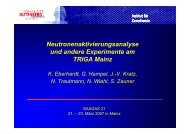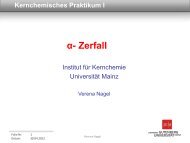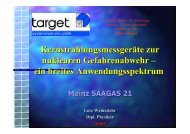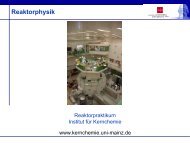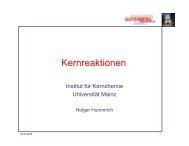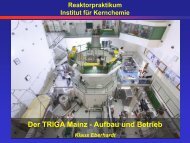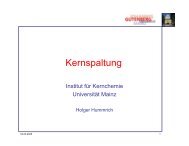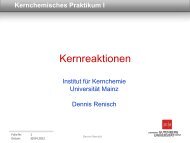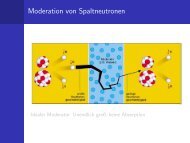jahresbericht 2007 - Institut für Kernchemie - Johannes Gutenberg ...
jahresbericht 2007 - Institut für Kernchemie - Johannes Gutenberg ...
jahresbericht 2007 - Institut für Kernchemie - Johannes Gutenberg ...
Create successful ePaper yourself
Turn your PDF publications into a flip-book with our unique Google optimized e-Paper software.
Development of the SPECTRAP experimental setup for laser spectroscopy of<br />
cold & trapped HCI ∗<br />
Z. Andjelkovic 1 , Ch. Geppert 1,2 , J. Krämer 1 , W. Nörtershäuser 1,2 , M. Vogel 2 , V. Hannen 3 ,<br />
Ch. Weinheimer 3 , D.F.A. Winters 3 , D. Church 4 , D. Schneider 5 , S. Bharadia 6 , D. M. Segal 6 ,<br />
R. Thompson 6 , and the HITRAP collaboration 2<br />
1 <strong>Institut</strong> für <strong>Kernchemie</strong>, <strong>Johannes</strong> <strong>Gutenberg</strong>-Universität, Mainz, Germany; 2 Gesellschaft für Schwerionenforschung,<br />
Darmstadt, Germany; 3 Westfälische Wilhems-Universität, Münster, Germany; 4 Texas A&M University, USA;<br />
5 Lawrence Berkeley National Laboratory, California, USA; 6 Imperial College London, UK<br />
The new SPECtroscopy TRAP (SPECTRAP) experiment<br />
under development within the framework of the HI-<br />
TRAP project will measure ground state hyper-fine splittings<br />
in cold, trapped, highly-charged ions (HCI) extracted<br />
from the HITRAP facility [1] by means of laser spectroscopy.<br />
It is a dedicated cryogenic (Penning) trap, laser<br />
and detection system, built in close collaboration with Imperial<br />
College London, TU Darmstadt, and the Universities<br />
of Münster and Mainz. The cryogenic surrounding allows<br />
for efficient cooling of ions during storage, thus opening<br />
the possibility for precision experiments with ions nearly<br />
at rest. Its optical accessibility (axial and radial) furthermore<br />
allows laser cooling, laser excitation and optical detection,<br />
making it an ideal tool for laser spectroscopy of<br />
HCI [2]. The trap will be operated with a Helmholtztype<br />
superconducting magnet, which was consigned to GSI<br />
by Lawrence Berkeley National Laboratory (LBNL), with<br />
courtesy of Prof. Dieter Schneider (LBNL) and Prof. Dave<br />
Church (Texas A&M University) who are also supporting<br />
the project. The system had previously been called RE-<br />
TRAP, and comprised, besides the magnet, a hyperbolic ion<br />
trap, ion manipulation and detection components as well<br />
as the corresponding electronic and cryogenic components<br />
[3].<br />
In March <strong>2007</strong> the RETRAP experimental setup was dismantled<br />
at Berkeley (see Fig.1), packed and prepared for<br />
shipment to GSI, where it arrived in May <strong>2007</strong>. By now<br />
a new platform for purposes of the SPECTRAP setup has<br />
been constructed next to the re-injection channel, and we<br />
have started mounting the newly-arrived equipment on it.<br />
At the moment, the magnet as well as the electronic and<br />
cryogenic system are being checked and prepared for implementation<br />
into the SPECTRAP experiments.<br />
A new open-endcap cylindrical Penning trap [4] has<br />
been developed and constructed at Imperial College in London,<br />
gold-plated at GSI and assembled. Starting already<br />
in 2006, off-line tests of the trap electrode structure were<br />
performed at Mainz University [5, 6]. It was operated in<br />
radio-frequency mode and loaded from an external argon<br />
ion sputter gun. Ar + ions were successfully stored for extended<br />
periods of time, and the obtained results have shown<br />
that the trap operated close to the expected parameters. In<br />
∗ Work supported by HGF under contract VH-NG-148 and the GSI<br />
F&E program.<br />
Figure 1: The RETRAP setup before shipment to GSI<br />
the next step, the trap will be mounted into the SPECTRAP<br />
magnet, and the work on the mechanical and electronic<br />
tasks for the purpose has started.<br />
In addition, the first laser system for the planned laser<br />
spectroscopy experiments was constructed and tested at<br />
Mainz University [6]. It consists of an external cavity diode<br />
laser, a reference Fabry-Perot interferometer for frequency<br />
locking and the corresponding electronics. Using a red<br />
laser diode (670 nm) the system was successfully tested<br />
by exciting Li atoms and observing the fluorescence. Future<br />
laser systems may include diodes with different wavelengths,<br />
ranging from 397 nm (UV) to 1550 nm (IR).<br />
References<br />
[1] T. Beier et al., Nucl. Instr. Meth. Phys. Res. B 235, 473<br />
(2005)<br />
[2] M. Vogel, D.F.A. Winters, D.M. Segal, R.C. Tompson, Rev.<br />
Sci. Ins. 76, 103102 (2005)<br />
[3] L. Gruber, J.P. Holder, D. Schneider, Physica Scripta 71, 60<br />
(2005)<br />
[4] G. Gabrielse, L. Haarsma, S.L. Rolston at Int. J. of Mass<br />
Spect. and Ion Proc. 88, 319, (1989)<br />
[5] Jörg Krämer, diploma thesis, Mainz University - <strong>Institut</strong> für<br />
<strong>Kernchemie</strong>, (March <strong>2007</strong>)<br />
[6] Zoran Andjelkovic, diploma thesis, Mainz University - <strong>Institut</strong><br />
für <strong>Kernchemie</strong>, (October <strong>2007</strong>)<br />
- A3 -



